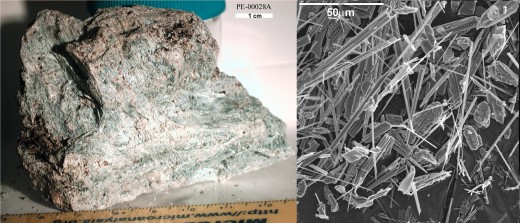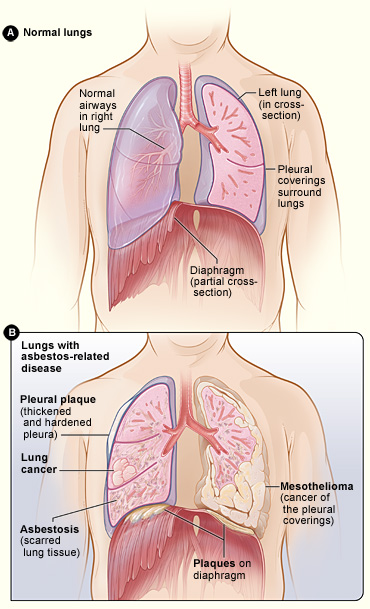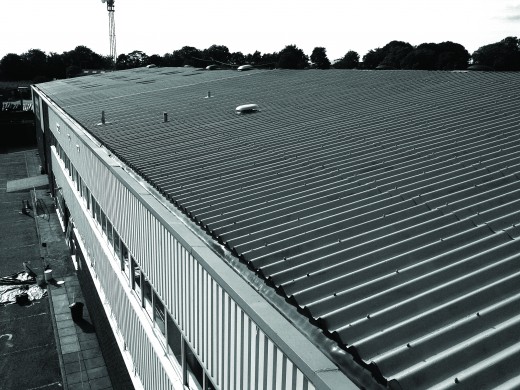What is Asbestos, and why is it dangerous?

You’re probably somewhat familiar with Asbestos by now. It used to be used quite often in construction, but in recent years, its use has declined, and now halted completely. You’ve probably also heard that Asbestos is fairly dangerous, and how people pay lots of money to have it removed from their homes. But why? What’s the panic?
Phrases and words throughout this article will link to other webpages defining them.

What is it?
As a material, Asbestos is a combination of six, naturally occurring silicate materials, comprised of fibrous crystalline structures. It’s usually white, but on the exterior, a block of Asbestos can have a dull, grey appearance.
Asbestos mining can be traced back to as far back as 4,500 years ago. However, mining only really started on a large scale around the turn of the 19th century, during the industrial revolution. Due to it’s unique, fibrous structure, the material was prized for its insulative properties, and also its strength. Asbestos found its way into many products, such as fabrics, car brakes, cooking equipment, and even gas mask filters.
But what the substance was most useful for, was construction. Asbestos has excellent fireproofing qualities, and also makes a good soundproofing material. This, on top of its strength and abundance, made it a very desirable material to work with. It was mostly used mixed into concrete or cement, as insulation in ceilings, roofs and on pipes.

What’s the risk?
Still, undisturbed Asbestos is perfectly safe. However, when disturbed or damaged, its true dangerous potential is revealed. Remember how I said that it’s fibrous? It’s those fibres that are the problem. The tiny, crystalline fibres can be released into the air as a form of dust if the Asbestos is drilled or cut, or if it snapped or cracked due to age and weathering. The dust can cause a lot of damage if one is exposed to it over an extended period of time. The fibres are tiny, and crystalline in nature, and are therefore very sharp – like armies of tiny, airborne knives.
Nellie Kershaw, a British cotton mill worker in the 1900s, worked with Asbestos through her entire career, weaving it into fabrics to be used in clothing and blankets. As time went on however, her constant inhalation of dust from the Asbestos she worked with eventually killed her. She died in 1924, and her death brought a lot of attention to dangers of Asbestos. Study of her lung tissue helped doctors diagnose her with what we now know as Pulmonary Asbestosis, the effect of having deposits of hundreds of Asbestos fibres jabbed into the lung tissue, forming a plaque. Asbestosis can develop into Mesothelioma, a cancer of the protective Mesothelium cells in the protective lining of the lungs.
(You can read more about Nellie in this other article of mine)
Due to the rampant dangers of Asbestosis, it was fully banned from being used further in 1999. However, there are still some countries where Asbestosis is continually mined and used in construction, but this is still becoming less common as time goes by, and new legislations are passed.

What can be done?
Sadly, Asbestosis and Mesothelioma are very difficult to treat, requiring complicated (and statistically rather unsuccessful) intrusive surgery, and chemotherapy. Most, if not all people with the diseases pass away due to their deliberating effects.
However, to prevent all of this ever happening to anybody, lots of measures can be taken.
If undisturbed and undamaged, Asbestos doesn’t pose any risk. But with the right equipment, Asbestos can be removed from and replaced in structures. However, doing so runs the risk of damaging the Asbestos and releasing the harmful dust, so upmost care must be taken when doing this. It is much better to hire a professional to do the job than to try doing it yourself.
Another, more unique solution, is encapsulating the Asbestos in a membrane. There are many liquid rubber membranes on the market that can be used on Asbestos roofs to encapsulate and waterproof the offending material. This ensures that, even if it is damaged, the harmful dust won’t be released.
Should I be worried about Asbestos?
Unless you live or work in an old building, I wouldn’t worry too much. However, if you are really concerned, then you can always find a professional to take a look at your home or workplace and check to see if Asbestos is present. And even then, I wouldn’t be overly concerned about it - unless it’s likely to get damaged of course. If it is likely to cause any trouble however, get it sorted by a professional as soon as possible. Mesothelioma is too much of a risk to throw under the rug.


Was this article helpful?
Did you get the answers you came here for?

About Me
I'm Lewis, an Internet Marketing Executive with LRS Systems. I spend way too much time on the internet as it is, so this job works well for me, as I can be around something I love to use.
In the company I work for, we have lots of customers who wish to encapsulate their Asbestos roofs. Working here has let me learn a lot about the risks attached to the material. I hope the dangers of Asbestos are vanquished soon.


If this article perked your interest, then you may want to read another article of mine, Nellie Kershaw - One victim of many. This article tells the story of Nellie Kershaw, the woman whose sad story helped highlight the dangers of Asbestos. Click here to read more.








